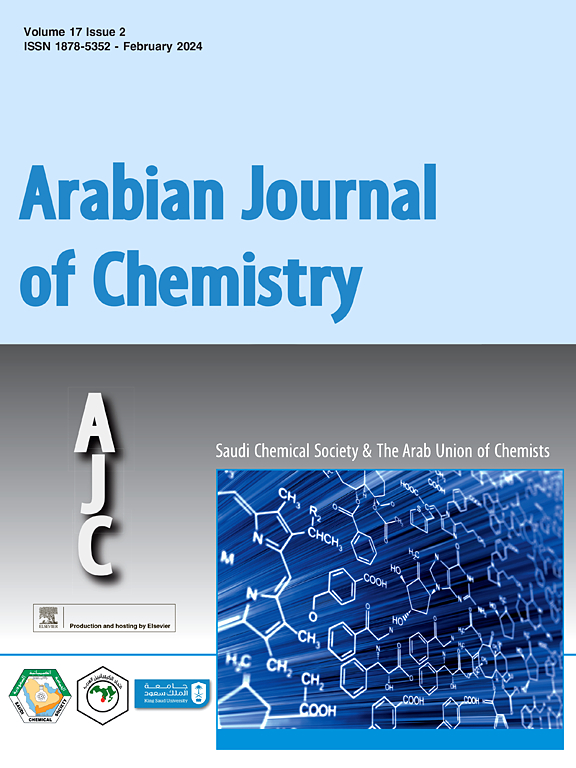Electrochemical sensing of gatifloxacin using Ag2S/RGO nanocomposite
IF 5.2
2区 化学
Q2 CHEMISTRY, MULTIDISCIPLINARY
引用次数: 0
Abstract
As a widely-used fluoroquinolone antibiotics, 1-Cyclopropyl-6-fluoro-8-methoxy-7-(3-methyl-1-piperazinyl)-4-oxo-1,4-dihydro-3-quinolinecarboxylic acid (gatifloxacin, GAT) has aroused much concern recently and it is of great importance to realize the accurate and efficient detection. Herein, the silver sulfide/reduced graphene oxide composite (Ag2S/RGO) was synthesized with one-pot method and was coated on the glassy carbon electrode to develop an effective electrochemical sensor for GAT. After the optimization of the size of Ag2S, the pH of buffer solution, and the scanning rate, the Ag2S/RGO modified electrode exhibits good linear relationship to GAT within wide ranges of 0.2 µM − 20 µM and 20 µM − 250 µM with a detection limit of 0.0667 µM. Besides, the proposed sensor shows good selectivity to GAT versus multiple interferences, including organic compounds, ions, and other antibiotics. At last, the proposed sensor was successfully applied in the GAT analysis in various real samples (including shrimp, fish, and chicken) with satisfying recoveries of 91.8 % − 102.4 %. In general, the proposed Ag2S/RGO-based electrochemical sensor provides a novel strategy for the GAT analysis, which is of significance for the development of efficient analytical techniques for antibiotics.
使用 Ag2S/RGO 纳米复合材料对加替沙星进行电化学传感
作为一种广泛使用的氟喹诺酮类抗生素,1-环丙基-6-氟-8-甲氧基-7-(3-甲基-1-哌嗪基)-4-氧代-1,4-二氢-3-喹啉羧酸(加替沙星,GAT)近年来备受关注,实现其准确高效的检测具有重要意义。本文采用一锅法合成了硫化银/还原氧化石墨烯复合材料(Ag2S/RGO),并将其涂覆在玻璃碳电极上,开发了一种有效的 GAT 电化学传感器。在对 Ag2S 的尺寸、缓冲溶液的 pH 值和扫描速率进行优化后,Ag2S/RGO 修饰电极在 0.2 µM - 20 µM 和 20 µM - 250 µM 的宽范围内与 GAT 呈良好的线性关系,检测限为 0.0667 µM。此外,该传感器对多种干扰(包括有机化合物、离子和其他抗生素)具有良好的选择性。最后,该传感器被成功应用于各种实际样品(包括虾、鱼和鸡肉)中的 GAT 分析,回收率达到 91.8% - 102.4%。总之,所提出的基于 Ag2S/RGO 的电化学传感器为 GAT 分析提供了一种新策略,对开发高效的抗生素分析技术具有重要意义。
本文章由计算机程序翻译,如有差异,请以英文原文为准。
求助全文
约1分钟内获得全文
求助全文
来源期刊

Arabian Journal of Chemistry
CHEMISTRY, MULTIDISCIPLINARY-
CiteScore
10.80
自引率
3.30%
发文量
763
审稿时长
63 days
期刊介绍:
The Arabian Journal of Chemistry is an English language, peer-reviewed scholarly publication in the area of chemistry. The Arabian Journal of Chemistry publishes original papers, reviews and short reports on, but not limited to: inorganic, physical, organic, analytical and biochemistry.
The Arabian Journal of Chemistry is issued by the Arab Union of Chemists and is published by King Saud University together with the Saudi Chemical Society in collaboration with Elsevier and is edited by an international group of eminent researchers.
 求助内容:
求助内容: 应助结果提醒方式:
应助结果提醒方式:


